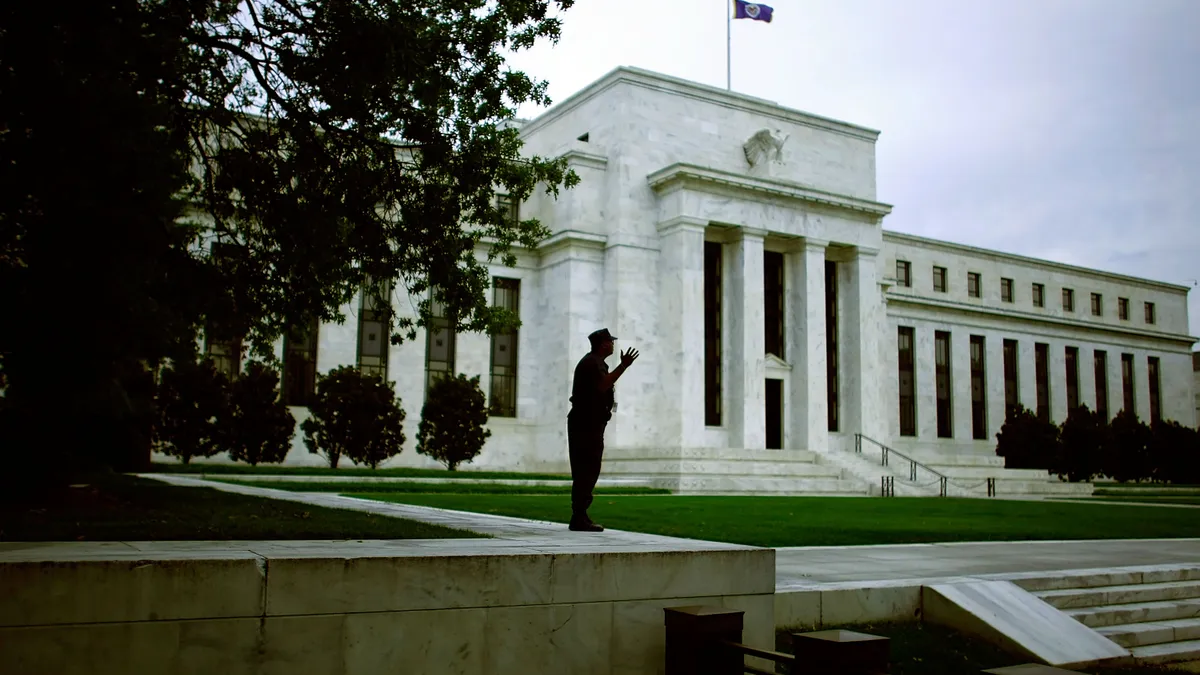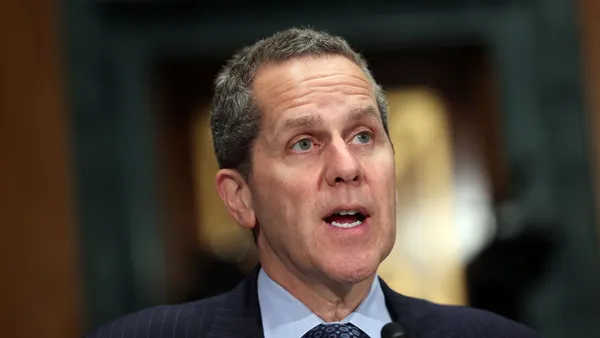Dive Brief:
- Goldman Sachs said Monday it would increase its dividend to $2.50 per share from $2 — the largest jump among the nation’s six largest banks after the Federal Reserve last week released the results of its annual stress test.
- JPMorgan Chase and Citi, meanwhile, held their dividends steady at $1 per share and 51 cents per share, respectively.
- Dividends saw a 13.6% average increase across the six biggest U.S. banks — far less than the 40.4% average jump between 2020 and 2021.
Dive Insight:
JPMorgan, for one, is keeping its dividend flat “in light of higher future capital requirements,” the bank said Monday in a filing. The bank’s Fed-mandated requirement for common equity Tier 1 (CET1) capital ratios relative to risk-weighted assets will jump to 12% starting in October, from 11.2% now, it said in the filing.
The Fed stress test “once again shows banks are able to be a source of strength for the broader economy while withstanding extreme market shocks,” JPMorgan CEO Jamie Dimon said in a statement.
“We continue to maintain a fortress balance sheet including robust governance and controls, strong revenue growth and profit margins,” he said. “We will continue to use our capital to invest in and grow our market-leading businesses, pay a sustainable dividend, and we will retain capital to fully satisfy our future regulatory requirements.”
JPMorgan this year announced a $30 billion stock repurchase plan that began May 1. A company spokesperson told CNBC the bank "continues to have board authorization for buybacks."
The nation’s largest bank isn’t the only one exercising an abundance of caution. Citi, for example, hasn’t changed its $0.51-per-share dividend since 2019.
“We are committed to executing the strategy we presented at Investor Day, improving our returns and delivering excess capital to our investors,” Citi CEO Jane Fraser said Monday, according to American Banker.
That bank, too, will see its CET1 requirement rise — to 11.5% from 10.5% — beginning in October. Bank of America’s, meanwhile, will jump to 10.5% from 9.5%.
Despite that, the Charlotte, North Carolina-based lender announced Monday it would increase its dividend to $0.22 per share from $0.21.
“Our responsible growth strategy over the last decade has put us in a strong position to support our clients and deliver for shareholders,” CEO Brian Moynihan said in a statement.
Morgan Stanley and Wells Fargo announced dividend increases, too. The former boosted its shareholder return to $0.775 per share, from $0.70, and announced plans to buy back up to $20 billion in stock.
Wells Fargo, meanwhile, is adjusting its dividend to $0.30 per share from $0.25.
“We are well-positioned to support our customers and communities, while also continuing to return excess capital to shareholders through dividends and share repurchases,” Wells Fargo CEO Charlie Scharf said Monday.
The bank in 2020 cut its shareholder payout to $0.10 per share but doubled it after last year’s stress test and increased it again midcycle.
Morgan Stanley’s increase Monday paled in comparison to last year, when it doubled its dividend. But in comparison to the nation’s other big banks, Morgan Stanley appears to have the most wiggle room. The bank’s new CET1 ratio will be 13.3% starting in October, compared with 14.5% at the end of March, according to the Financial Times.
Goldman’s 25% dividend increase falls far short of the 60% by which it boosted the shareholder return last year. Though it still marks the biggest uptick by a top-six bank this year.
“Our client-oriented strategy will continue to diversify the firm’s franchise and provide a strengthened return profile,” CEO David Solomon said in a statement. “We will continue to dynamically manage capital and remain well-positioned to support our clients.”
The bump comes even though Goldman will be hit with an additional 50-basis-point surcharge on its CET1 capital requirements beginning next year because of its status as a systemically important bank.
Stress test blowback
Dividend increases weren’t limited to the six largest U.S.-based banks. State Street boosted its dividend 10% on Monday to $0.63 per share, according to Bloomberg. BNY Mellon hiked its dividend 9% to $0.37. And Truist bumped its quarterly shareholder return 8% to $0.52 per share, the wire service reported.
Results were published Thursday for the Fed’s stress test of 33 banks with the largest operations in the U.S. Under the test’s severely adverse scenario — which sees unemployment jump to 10%, commercial real estate prices drop 40%, home prices dip 28.5% and stock prices plummet 55% — the banks’ aggregate common equity capital ratio would be expected to dip to 9.7%. That would still be more than double the minimum 4.5% the Fed requires — a prospect that has drawn blowback from liberal-leaning lawmakers that perhaps the test is too easy or takes the wrong benchmarks into account.
“Wall Street bank CEOs have raised the alarm bells that an economic hurricane is coming, but the reality is that the largest banks aren’t doing what they need to do to protect the economy from the next crisis,” Sen. Sherrod Brown, D-OH, said Thursday after the stress test results were posted. “Instead of building up capital to withstand losses or investing in the real economy and workers, they’re planning to spend $80 billion in stock buybacks and dividends.”
Phillip Basil, director of banking policy at Better Markets, asserted that even though this year’s stress test scenarios were more severe than last, the test measured familiar variables and mirrored or amplified past market shocks rather than anticipating new issues.
“Despite this being a more, at least on paper, stressful scenario, it's a very bread-and-butter scenario that the banks are well positioned to handle,” he told American Banker.
Randal Quarles, the Fed’s former vice chair for supervision, told the publication Basil’s characterization of the scenarios as “vanilla” may be warranted. Quarles said he advocated including a wider array of test criteria that would require results to be averaged over several years when setting capital requirements. But the fluctuations that would cause in capital requirements for some banks made such a test ineffective, he said.













